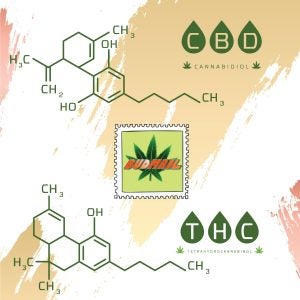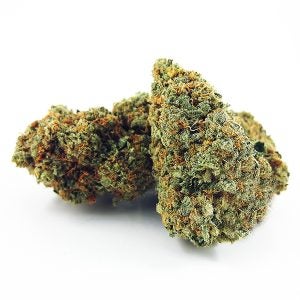Since cannabis’s legalization, there’s been a pivot from prizing strains for their THC effects to celebrating the benefits of CBD. In fact, the popularity of CBD products is growing at lightning speed—some analysts are predicting that the CBD market alone will be valued at $22 billion by 2022.
So what’s all the hoopla about? Do the benefits of CBD really outweigh those of cannabis’s more mind-altering properties? Is THC just about getting high or does it offer us something more? Let’s take a closer look at cannabis’s two main compounds to see what sets them apart and, most importantly, how they can work together.
Cannabinoids Explained: What are CBD and THC?
To understand THC and CBD, we first need to understand cannabinoids. Simply put, cannabinoids are chemical compounds stored in the flower’s trichomes (crystals), which give cannabis its medical and recreational properties. Of the 100-plus cannabinoids found in cannabis, the plant’s two main players are tetrahydrocannabinol (THC) and cannabidiol (CBD).
While cannabinoids aren’t the only compounds that make up the plant (there are also terpenes, which give cannabis its unique flavors and scents), they’re the ones that interact with our endocannabinoid system (ECS)—a network that spreads throughout our bodies with receptors situated in our central nervous system (CB1 receptors) and immune system (CB2 receptors). When we consume cannabis, cannabinoids such as THC and CBD interact with these cannabinoid receptors, thus producing cannabis’s many sensations (euphoria, increased appetite, decreased anxiety, etc.).
What is THC?
THC is the principal psychoactive compound in cannabis. While we’re not exactly sure why the cannabis plant produces this compound, there are several theories suggesting that it aids in the plant’s survival. For instance, THC works as a pretty good deterrent against UV exposure. The molecule also has antibiotic properties, protecting the plant against pathogens. It’s even quite possible that the high the compound produces serves as a defense mechanism against smaller natural predators.
How Does THC Interact with Our Bodies?
When we consume THC, the compound binds with our CB1 and (to a lesser extent) CB2 receptors, causing communication between neurons to get a little scrambled. This miscommunication is what we perceive as “being high.”
What are the effects of THC?
Most of us feel a general sense of euphoria, which is brought about by the cannabinoid’s interaction with receptors associated with short-term memory, pleasure, as well as time and spatial awareness. Increased heart rate is also quite common.
These sensations are often followed by elevated appetite (aka the munchies), drowsiness, and a sense of contentment. When consumed in high doses, THC can sometimes lead to anxiety and paranoia. THC also has the ability to alleviate pain and nausea, which is why chemotherapy patients are often prescribed high-THC strains.
What is CBD?
CBD is the second most prominent cannabinoid in the cannabis plant. At first glance, CBD and THC look nearly identical; both feature the same amount of hydrogen, oxygen, and carbon atoms. It’s merely a single hydrogen atom that creates the structural difference between the two.

CBD vs THC Composition
While microscopically minor, this atomic detail produces effects that are worlds apart. Namely, unlike THC, CBD it’s nonintoxicating. It interacts with our receptors in an entirely different way. This unique interaction is what gives CBD its numerous therapeutic benefits as well as its ability to curb some of the less enticing effects of THC.
How Does CBD Interact with Our Bodies?
Unlike THC, CBD does not bind to our CB1 receptors (well, technically it does but only with an extremely low affinity); rather, it interacts with them indirectly and alters the way they work. By changing the structure of our CB1 receptors, CBD makes us more receptive to cannabinoids produced naturally by the body such as anandamide and 2-AG. Moreover, by altering these receptors, CBD also inhibits some of the effects of THC (more on this in a minute).
What are the Effects of CBD?
There is growing evidence that CBD has several medical benefits, particularly for treating rare forms of childhood epilepsy such as Dravet syndrome and Lennox-Gastaut syndrome. Pain, inflammation, and even Chron’s disease are also afflictions CBD has been known to relieve.
It’s worth noting that nonintoxicating does not mean non-psychoactive. Although CBD doesn’t produce the hyper-sensorial effects THC does, it still very much impacts on our psyche. Commonly, it’s used for anxiety, depression, and PTSD. It treats these conditions by influencing not only cannabinoid receptors but also serotonin receptors (among several others).
It also inhibits dopamine pathways—the sets of neurons in the brain that create a sense of reward and, as an unfortunate result, facilitate addiction. By blocking dopamine pathways, CBD potentially aids individuals struggling with opioids, alcohol, and other dopamine-triggering substances.
CBD and THC: How they Interact With One Another
CBD’s ability to transform CB1 receptors can actually block some of the effects of THC. As a result, CBD may not always be a welcome addition to THC consumption. Glaucoma suffers, for example, should be aware that CBD can hinder THC’s ability to treat the condition.
Of course, we needn’t always approach the relationship between the two cannabinoids as some sort of CBD vs THC showdown; they’re not duking it out so much as they’re having a conversation.
The Entourage Effect
CBD inhibits some characteristics of THC, but it also it elevates others. Conversely, THC has the ability to support many of CBD’s advantages. It’s called the entourage effect—the idea that cannabinoids are more beneficial to us when they’re part of a symbiotic relationship.
Paranoia and anxiety, for instance, have been known to be less prominent in high CBD strains. CBD also has the ability to curb the munchies brought about by THC, allowing us to enjoy our high without the added calories.
Moreover, studies have shown that when combined with THC, CBD provides greater pain relief for people suffering from cancer. Nabiximols (Sativex), a drug commonly prescribed to cancer patients, contains a 1:1 ratio of CBD and THC.
High CBD Strains
Apart from CBD extracts, there are also numerous high-CBD/low-THC strains available. The most popular of which is probably the Harlequin strain, which features a 5:2 CDB to THC ratio. The hybrid strain is sativa-dominated, meaning users can expect increased energy (it’s a good strain for the gym) and only mild euphoria. Its high CBD levels make it a popular bud for chronic pain relief and anxiety.

CBD Harlequin Flowers
Other popular high-CBD strains include ACDC, Stephen Hawking Kush, Charlotte’s Web, and Ringo’s Gift (the latter two feature roughly 20:1 CBD to THC ratios (!) and are thus almost exclusively used for therapeutic purposes).
THC and CBD Oils
A flower’s total THC hovers around 20-percent. But when it comes to oils, potency increases drastically. Hash oils (often marketed as honey oils) can be incredibly THC-rich, ranging anywhere from 70 to 90-percent!
On the other end of the spectrum are CBD oils…CBD oils for pain, CBD oils for anxiety, CBD oils for dogs—seems like there’s a CBD oil for just about everything these days! But don’t worry; knowing what to look for isn’t as complicated as it seems.
One piece of advice for first-time buyers is to not confuse hemp oil for CBD oil. While CBD can be naturally extracted from the hemp plant, products labeled hemp oil are generally produced from the plant’s seeds and contain only small amounts of CBD (if any at all). So while hemp oil certainly boasts a slew of benefits, it’s not truly a CBD product.
Isolate vs Full-Spectrum CBD
There are numerous cannabidiol extracts available for those who don’t favor the euphoric effects of THC. One such product is CBD isolate, which is 100-percent CBD and generally comes in a powder form.
For years, it was thought that isolate was the purest and most efficient way to reap the benefits of CDB. Recently though, clinical studies, robust anecdotal evidence, and our increased understanding of the entourage effect reveal that CBD is far more effective when combined with other cannabinoids, specifically THC.
With full-spectrum CBD products, the cannabinoid is accompanied by a few of its sister molecules. Yet unlike medications such as Nabiximols, which uses a 1:1 ratio, full-spectrum CDB products incorporate only small amounts of THC as well as a few other cannabinoids and terpenes.
Nevertheless, these minute additions make a big difference for its users. How? Truthfully, we’re not exactly sure just yet. The synergistic effect between cannabinoids is highly complex and something we’re only beginning to understand.
Which Ratio is Right for You?
Finding the formula that fits you best requires a little homework. Start slow and, as you experiment, take notes of the sensations you enjoy along with those that you don’t. If you’re using extracts or concentrates, calibrate just a little at a time and always be conscious of your dosage. Read reviews of different strains but also bear in mind that no two users experience the effects of THC and CBD exactly the same. Everyone has their own sweet spot.
